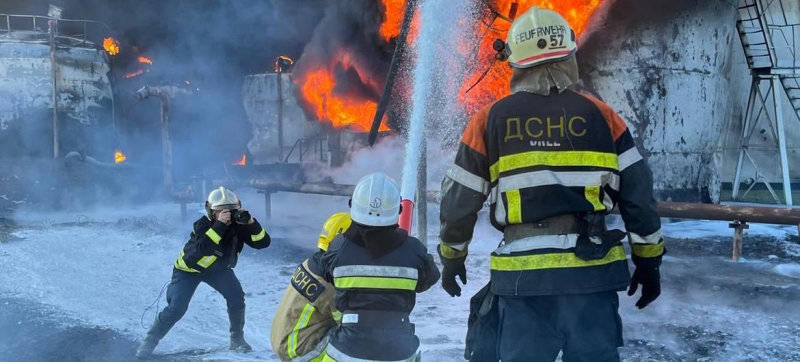
Liquidation of the consequences of missile shelling in the Kyiv region (July 2024) Victoria Ruban: “A rescuer is a person who will always help” Anna Radomskaya Peace and security
When you meet a person in a uniform with a “Rescuer” patch (ed. – “Rescuer”) on the street of a Ukrainian city, the feeling is the same as if you met a superhero from a science fiction movie. An unusually calm and sunny Kyiv morning is not a reason to relax for the employees of the Emergency Situations Service.
“If before we slept more or less peacefully, now everyone knows that when an air raid alarm sounds, anything can happen. We are constantly ready,” Victoria Ruban, head of the press service of the Main Department of the State Emergency Service of the Kyiv region, told the UN News Service. She has worked here for over twenty years.
Rescuers are real heroes for Ukrainians today, who are the first to arrive at the sites of rocket attacks, free people from under the rubble, fight fires for days on end, and demining areas.
“Even though I am the head of the press service, don’t let it seem like an office job to you, because we are always there where things are the most difficult. Once, during an explosion, my pants even burned. I often walk in front of my guys, because I am filming. And if necessary, I do other work, if the situation requires it,” says Victoria Ruban.
The war has made adjustments to the work of rescuers
The war changed the work of rescuers. According to Victoria, in the first month of the occupation of the Kyiv region, she had to leave her work in the press service and perform other duties: “All of us, regardless of our positions, sat as dispatchers on the 101 line and took calls from people from all over the region. Then I worked in a camp where people evacuated from Bucha and Borodyanka were brought. We met them near the Romanovsky Bridge (in Irpen). On March 5, the first day of the evacuation, we began to set up a camp there. There was a very difficult crossing there – you had to go through water. And we tried to meet those people who were crossing, to somehow help them. People ran out to us from under the bridge in their pajamas, confused, some were wounded.”
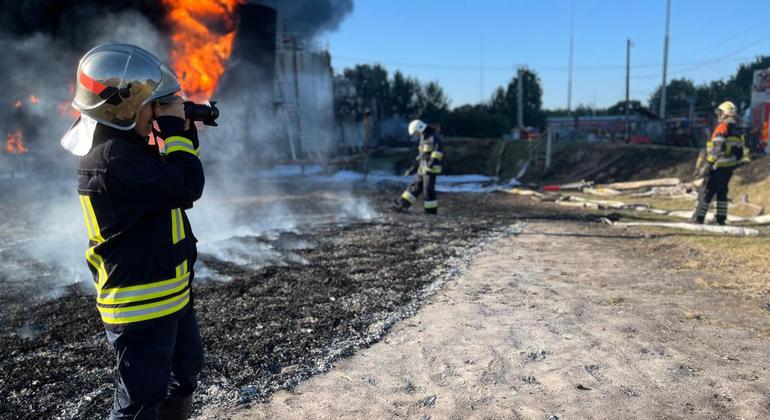
“We were lucky that we stayed then alive”
When Russia’s full-scale invasion of Ukraine began, Victoria accompanied evacuation buses with civilians. She recalls that time with horror and at the same time states: “That was our job.”
“When evacuation columns began to leave Belogorodka (these were the so-called “green corridors”), I was the senior of these columns. We went to Bucha, Borodyanka, Nemeshaevo, evacuated people. From 10 to 40 buses followed us at once. We were lucky to stay alive then. There were many terrible cases. On the way to Bucha, we passed five or six checkpoints, at each one we were stopped, everyone was checked. There were a lot of people, there was panic, very different situations developed,” says the head of the press service of the State Emergency Service.
A particular problem in the Irpen zone were hospices and nursing homes, where at that time there were many elderly people, patients with complex diagnoses. “I remember how 42 people were brought from there (aged 80 plus). Many of these people did not remember their last names. Only three days later we learned that each of them had a piece of paper with information about themselves in their pocket. As it turned out later, the head of the institution had fled, and only one nurse remained with the patients. And all these people needed to be placed somewhere. There were many such situations,” says Victoria.
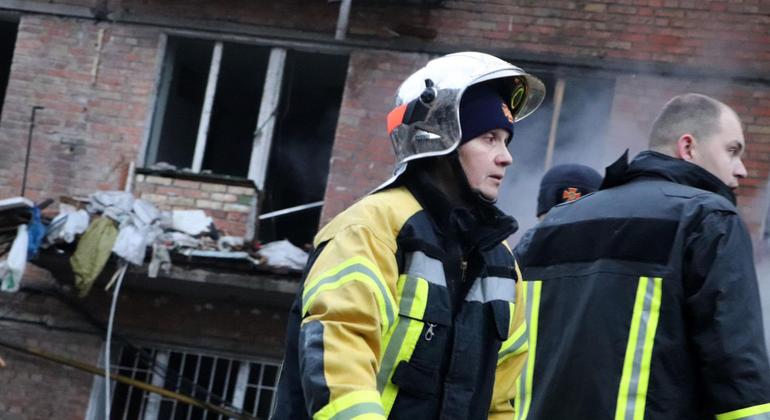
“He couldn’t leave her… I will always remember this!”
There were people during the evacuation who, according to Victoria, were especially memorable – for their courage, kindness and humanity.
“This was the first evacuation from Bucha. We had only 12 buses, and there were a lot of people, five times more than there were seats. Then the first column was able to take only 30 percent of everyone who came to the square. And so I was walking, and a young guy came towards me, pushing an old frail granny in a garden wheelbarrow. It was cold and she was lying there so small, all wrapped up. The guy was pulling her, practically crying and asking: “Take her!” I asked: “Is this your relative ?” He answered: “No, she is my neighbor. I have a wife and child there, but until I give you my granny, I can’t do anything, I have to be calm about her.” He gave us the wheelbarrow, and I promised that we would take the granny. Our employees took her into the bus, and the guy ran on. He couldn’t leave her – it struck me so much. I will always remember it. After all, it speaks volumes about a person!
Victoria recalls various difficult situations, from which they, the rescuers, still managed to find a way out. “There was a situation when the evacuation was through a field. The sun warmed up, the ground thawed a little and the buses began to load – and all this shortly before the curfew between checkpoints. People had to be asked to get out and they walked in a column next to the buses, which were traveling through the ploughed field,” says the head of the press service of the State Emergency Service.
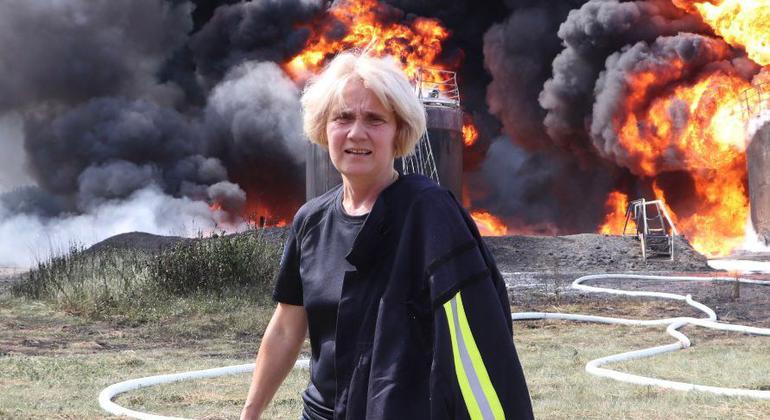
“People fell, but they dragged their pets”
People with animals are a separate page of our heroine’s memories. “I remember how people fell, but they dragged their pets. A girl was dragging two cats. She was all scratched. We helped her pack the animals in boxes – we made improvised carriers for them and then sent them off with their owner. Many animals were just running around the city. Volunteers gave me collars with leashes and we caught dogs, helped them, and then handed them over to the shelter. My separate page is a black Labrador. I saw him running along the street. At first, I didn’t know what to do with him, I thought about taking him for myself, but I understood that no one was home, the dog would get lost alone. We fed him porridge. I took him and saw that tears were flowing from his eyes, just like a person’s. He put his paw on my knee. My boss was standing nearby and watching this drama. He silently took the dog, took it to his car and took it home to his wife. Now it is the best friend of his family,” Victoria smiles.
“I brought a cat from Borodyanka, he then lived at work. And from Dmitrovka we brought a spaniel. We were standing on the side of the road in a company car, I opened the doors, and the dog ran up to me. So dirty, exhausted. I brought her home, bathed her. But my cat was unhappy, started chasing her. Anyway, now my son’s girlfriend has a spaniel,” Victoria laughs. “The heroic cat from Borodyanka, which our rescuers took down from the high floor of a destroyed house, was also taken by our girls. The owners did not look for most of the animals.”
“The most terrible thing is clearing rubble”
The most terrible thing in the work of rescuers is clearing rubble, – admits Victoria. “Very few people can be saved in such a situation, many die. Now our guys are simply performing feats, especially in the Kharkiv region. I am from Kharkiv myself, my relatives live in Saltovka – an area that is regularly shelled. What can I say … It’s terrible. Our guys there are simply heroes, they are under attack there every day.”
“It is impossible to get used to the death of people”
“What should a rescuer be like? Firstly, stress-resistant, – the head of the press service of the State Emergency Service is sure. – A rescuer is a person who will always help. Everyone comes to this profession differently. But when you get there, an inner core is developed. And then you understand – I love this job! I love it because people are grateful to you.”
“But it’s impossible to get used to the death of people, even when you’re a SES specialist,” says Victoria. “The hardest thing is the reaction of loved ones when they’re clearing rubble and there are people’s remains, in the dust, in the concrete. I remember how in Borodyanka my mother sat for two days next to the house that was being dismantled and waited for them to find her children (her son and daughter). She showed them their photos. Rescuers found the remains of her family in the basement… When you see all this, it’s very difficult to go through it. That’s why rescuers also undergo rehabilitation. But the guys understand what kind of job they have. They just live this life. They understand that they are needed.”
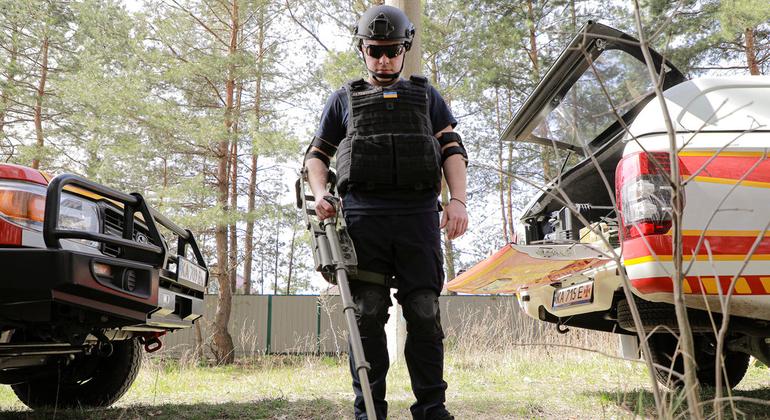
The rescue service unites many professions
Nowadays, the rescue service unites many professions. “If earlier it was mainly the fire protection, now it is the diving, medical, chemical, and radiological services. A rescue department has been created, whose employees go out to clear rubble. Pyrotechnicians, the number of which has increased significantly over the past two years – entire units have appeared, which will have enough work for 50 years to come,” says the head of the press service of the State Emergency Service.
Support for Ukrainian rescuers is one of the priorities of the UNDP
Assistance to rescuers, especially sappers and pyrotechnicians, is one of the priorities of the UN. Today, Ukraine is one of the countries in the world most contaminated with explosive devices. The United Nations Development Programme (UNDP), with funding from the European Union and the governments of Denmark, Sweden and Japan, has equipped more than a thousand SES pyrotechnicians – almost 80 percent of the country’s pyrotechnic brigades. UNDP is also testing new equipment (aerial drones, robots) that would facilitate the process of searching for explosive objects, since the areas to be demined are huge.
“We have enough people now. We have new, normal equipment. Compared to what we had before, it’s like night and day. Together with the UN, we conduct training events on mine safety for children, which is very important, since many areas are still mined,” Victoria Ruban sums up.
